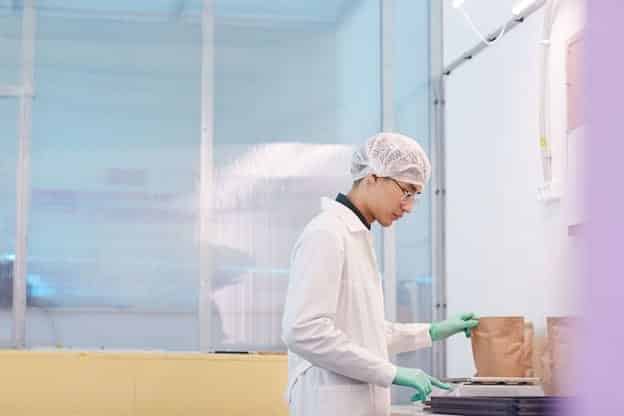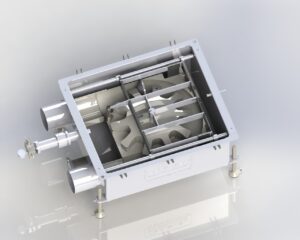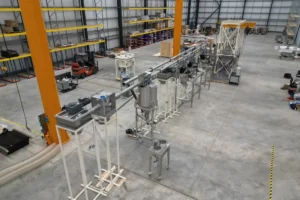Freezing is one of the best and most affordable ways of prolonging the shelf life of various foods. But how to maintain the quality and safety of frozen foods? Though other emerging technologies, such as infrared irradiation, microwaving, pulsed electric field, and ultrasound, are gaining more attention, freezing remains a dominant food preservation method.
Ensuring quality and safety in frozen items requires careful handling throughout the entire cold chain for frozen foods, from preliminary treatments and processing to packaging, storing in frozen conditions, transportation, and eventual defrosting. Freezing preserves food by physically changing the state of a substance’s water content into ice by cooling it. However, even though this will slow down the physicochemical and biochemical reactions that influence food spoilage, it will not completely stop them. The loss in quality of frozen foods is largely dependent on the entire process, storage temperature, the length of freezer storage time, and the thawing procedure.
How Does the Freezing Rate Affect Frozen Food Quality?
Managing the full freezing procedure is vital for delivering top-notch frozen foods. A significant factor in this is the speed of freezing. Typically, rapid freezing yields higher quality compared to a gradual process.
For fresh vegetables and fruits, the rate at which they are cooled affects the ice crystal formation and the extent of cell wall disruption. A compromised cell structure can turn what should be crunchy food into something soft.
When freezing poultry, fish, or meat (including ground meats), water tends to leave the cells during freezing. Quick freezing reduces this loss of moisture and preserves texture. Quicker crystal formation results in tinier ice crystals, causing lesser harm when foods are frozen. On the other hand, when defrosting goods, a gradual warming up to ambient temperature enables water to re-enter the cells.

Microbial Cultures
The detrimental effects of freezing on microorganisms may or may not be desired, depending on the type of food frozen. Here are the instances to consider:
- Microbial growth is not desirable when foods do not contain any beneficial cultures.
- In foods that do contain beneficial microbial cultures, maintaining their activity is essential. In frozen dough, for instance, rapid freezing will have a detrimental effect on yeast activity.
How to Prevent Microbial Spoilage?
When it comes to food safety, the key is maintaining a delicate balance between preserving quality and preventing microbial spoilage. The ideal storage temperature for vegetables, fruit, or meat ranges from 16°F – 10°F.
Microbiological spoilage can be avoided by following basic hygiene guidelines such as proper cleaning procedures, heat processing, and cutting raw materials into smaller pieces if possible. Generally, freezing will kill between 10 and 60% of the viable microbe population, depending on the freezer temperature and frozen storage time.
In terms of microorganisms, there is a considerable difference between their sensitivity to freezing and how quickly they can grow once the product is thawed. Special attention needs to be given here as some microbes can lead to spoilage, various food-borne illnesses, and food poisoning.

Quality of Frozen Food and Physical Changes
Certain physical transformations occur during the freezing of food. Let’s discuss some of the most prevalent changes that manufacturers have to take into account when planning production operations.
Weight Loss
Products that are not packaged can experience moisture loss when frozen. Meat can shed about 3% of its weight while freezing and as much as 6.15% when frozen, followed by 20 hours of refrigeration.
Recrystallization
During the freezing stage, in freezer bags or containers, there’s a transformation in the quantity, dimension, and form of ice crystals. Smaller crystals merge, forming bigger ones, which can diminish the overall quality and reduce the shelf life.
Retrogradation
Deterioration in baked products is due to staling and the process of starch retrogradation. This phenomenon is most pronounced when the product is above its freezing point. Quick freezing helps maintain the product’s freshness.
Protein Denaturation
Freezing leads to changes in protein structure and its solubility. For instance, the degradation of fish during storage is linked to reduced protein solubility, negatively impacting its nutritional content. In frozen uncooked meat and poultry, factors like the ability to retain water, enzyme functions, and surface hydrophobic properties are influenced by this process.
Freezer Burn
Loss of moisture resulting in freezer burn is a common issue. Managing this dehydration can be achieved through methods like adding humidity, maintaining colder storage conditions, or using improved packaging techniques.
Frozen Food Quality and Chemical Changes
In addition to the tangible transformations, chemical alterations also occur, impacting the quality of frozen items. Some of these changes encompass:
- Rancidity – The presence of oxygen can impact the majority of frozen items. When exposed, oxidative spoilage can occur. This can result in discoloration and the development of undesirable tastes. The freezing process intensifies solutes, leading to cell membrane dehydration and making them more susceptible to oxidation.
- Color, aroma, and flavor loss – Alterations in color in many frozen fruits and vegetables are due to shifts in the innate colorants in plant cells, enzymatic discoloration, and the degradation of cell structures like chloroplasts and chromoplasts. For poultry, a lighter surface hue is desired, and this can be best accomplished through rapid surface freezing. Moreover, this can influence the taste and scent of the frozen items.
- Vitamin loss – Preserving the nutritional content of foods using any preservation technique can be a complex task. However, freezing stands out as one of the methods that cause the least damage. For instance, while the degradation of ascorbic acid (vitamin C) can take place, the overall decrease is influenced by various aspects such as the method used, type of packaging, preparatory measures, and storage environments. Oxidation is the primary factor leading to vitamin depletion.
- Enzyme release – Freezing causes the breakdown of both plant and animal tissues, resulting in enzyme release. Near 32°F, the primary degradation of product quality arises from the enzymatic deterioration of proteins.
- Acetaldehyde formation – During storage, this phenomenon takes place in frozen vegetables, impacting their longevity. The production of acetaldehyde is influenced by the efficiency of the blanching technique and the effectiveness of storage.
Freezing Pre-Treatments
It’s essential to recognize that a successful freezing process will only retain the already existing food quality and will not improve it. Maintaining the quality and safety of frozen food starts with pre-treatment. The most common pretreatments will be discussed below.
Blanching
The majority of vegetables and some fruits undergo blanching before freezing. This is a process of scalding fruits or vegetables in boiling water or steam for a brief time. This process destroys the permeability of cell membranes, removes intercellular air, and fills those spaces with water. As a result, ice crystallization can form over the entire surface without interruption. It also preserves foods’ texture, color, flavor, and nutrient content by deactivating their enzymes.
Heat Treatments
Maintaining proper texture is important when dealing with fruits and vegetables. Heat treatments help maintain their firmness while killing microorganisms that may be present. For example, carrots heated for 30 minutes at 140°F and then frozen at the optimum rate of 23°F/min will avoid cell damage and excessive softening. Common foods that undergo heat treatments include cooked foods, some vegetables, meats, and fish.
Dipping Treatments
In some cases, foods are immersed in different solutions before freezing. Apple slices, for instance, are usually soaked in a 1% salt solution to remove intercellular air. Fruits are generally dipped in ascorbic acid and various sugar solutions to minimize browning. Glazing compounds are also used to add a protective layer of coating against dehydration and oxidation. Sodium acid phosphate, sodium carbonate, calcium lactate, ascorbic and citric acids, glutamic acid, and some corn syrup solids, among other solutions, can be used for glazing.
Cryoprotection
Cryoprotectants such as sugars, amino acids, polyols, methylamines, or carbohydrate polymers are compounds introduced during processing or product formulation, or they may occur naturally. This helps prevent adverse changes in foods during the freezing and thawing processes.
The Three Essential Steps – Storage, Packaging, and Thawing
The packaging, storage, and thawing processes also affect frozen food quality. The detrimental effects on quality and food safety are slow, gradual, cumulative, and irreversible. It has been revealed that aluminum foil laminated packages best limit oxygen permeability, light transparency, and water vapor transmission.
Storage and distribution temperatures need to be kept at 0°F or lower to maintain quality. Every 9°F increase over 0°F increases the rate of quality loss by about 200 to 250%. The amount of goods in a storage unit can affect temperature fluctuation.
Some food types, such as pork, fish, fried chicken, animal organs, and spinach, can be high quality only for about 3 to 7 months at -4°F. In contrast, sugared fruits, beef, most vegetables, and bakery products can be maintained over one year under the same conditions.
Thawing is the final step and is essential to the quality and safety of frozen foods. Microbiologically safe methods of defrosting foods are to store foods in the refrigerator at temperatures below 41°F, microwave, or cook.

How to Maintain the Quality and Safety of Frozen Foods – Add a Tubular Conveyor to the Processing Facility
All steps that the frozen food cold chain entails have to be considered to ensure the quality and safety of goods. Cablevey’s frozen food conveyor systems will facilitate quality and safety throughout the food production and freezing process, from pre-treatment, mixing, freezing, safe food handling, and packaging.
While stainless steel tubular conveyor is seen as the most “clean” and sanitary, and when it comes to most frozen food applications, clear-vinyl tubing also has the added benefit of reducing the incidence of black specks occurring on the product. What is more, advanced automated conveyor systems can reduce material breakage significantly.
Unfortunately, this is an all-too-common issue with other systems, particularly open-conveyor belt systems or bucket elevators. Being enclosed systems, tubular conveying systems are also better equipped to eliminate product spillage, warming, and cross-contamination from the environment. Don’t miss out on an opportunity to invest in a cutting-edge automatic conveyor system.
Reach Out to Tried and Tested Conveyor Systems Manufacturers
If you are looking for a conveyor manufacturing and conveyor engineering company, reach out to Cablevey Conveyors. Cablevey’s frozen food conveyor systems are available in different sizes and offer various components to cover any facility layout and frozen food conveying needed. Make sure to contact us and talk to our team of conveyor manufacturers, that can provide more information about tubular conveyors and their differences when compared to belt conveyor systems. Apart from this, ask about the conveyor installation supervision service before ordering your equipment.






